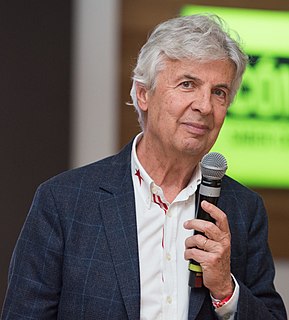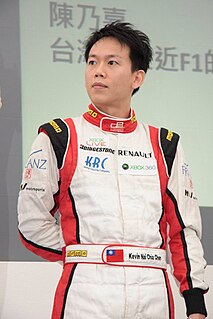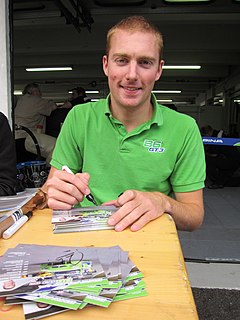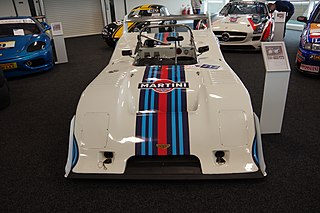
Gunnar Axel Arvid Nilsson was a Swedish racing driver. Before entering Formula One, he won the 1975 British Formula 3 Championship.

Harald Ertl was an Austrian racing driver and motorsport journalist. He was born in Zell am See and attended the same school as Grand Prix drivers Jochen Rindt, Helmut Marko and Niki Lauda.

Hesketh Racing was a Formula One constructor from the United Kingdom, which competed from 1973 to 1978. The team competed in 52 World Championship Grands Prix, winning one and achieving eight further podium finishes. Its best placing in the World Constructors' Championship was fourth in 1975. Hesketh gave James Hunt his Formula One debut and he brought the team most of its success. Alan Jones also began his Formula One career in a privately entered Hesketh.

Adolf Brudes von Breslau was a Formula One driver from Germany and a member of German nobility. He started racing motorcycles in 1919. As an owner of a BMW and Auto Union dealership in Breslau, he had the opportunities to go racing, which he did from 1928 onwards, initially in hillclimbs. After World War II wiped out his business, he moved to Berlin and for a while became a mechanic, wherever he could find jobs. However he soon was back racing, and he continued until 1968, in hillclimbs – an amazing career of 49 years! He participated in one World Championship Grand Prix, the 1952 Großer Preis von Deutschland, but scored no championship points. He also participated in several non-Championship Formula One races.

Emilio de Villota Ruíz is a former racing driver from Spain, born in Madrid. He entered 15 Formula One World Championship Grands Prix between 1976 and 1982, qualifying twice. He entered most Spanish Grand Prix between 1976 and 1982 and became a major force in the short-lived Aurora AFX Formula One Championship for F1 cars, winning the title in 1980.

Jörg Müller is a Dutch-born German BMW factory driver.

Didier Theys is a Belgian sports car driver. He is a two-time overall winner of the 24 Hours of Daytona ; a winner of the 12 Hours of Sebring (1998); the Sports Racing Prototype driver champion of the Grand-American Road Racing Association (2002) and the winner of the 24 Hours of Spa. He was also the polesitter (1996) and a podium finisher at the 24 Hours of Le Mans. The podium finish in 1999 was a third overall in the factory Audi R8R with co-drivers Emanuele Pirro and Frank Biela. Theys' first appearance at Le Mans was in 1982, while his last start in the world's most famous endurance sports car race came 20 years later in 2002.

Alexandros "Alex" Margaritis is a Greek-German racing driver who is best known for competing in the German-based Deutsche Tourenwagen Masters touring car championship. Prior to that, his career had focused on formula single seater racing in Europe. Margaritis has dual nationality as a result of his place of birth and Greek parentage.
Anthony Lawrence Longhurst is an Australian racing driver and former Australian Champion water skier. He is most noted for his career in the Australian Touring Car Championship and V8 Supercar series. Longhurst is a two-time winner of the Bathurst 1000, winning the event in 1988 with Tomas Mezera and in 2001 with Mark Skaife, and is one of only five drivers to win Bathurst in both a Ford and a Holden.

Kevin Nai Chia Chen is a Taiwanese racing driver, who obtained the first FIA A license by a Taiwanese driver.

John Michael Edwards is an American professional racing driver, and BMW Motorsport works driver.
Josef Král is a professional racing driver from the Czech Republic.
Michael James Lewis is an American race car driver born on December 24, 1990 in Laguna Beach, California to parents Steve Lewis and Loretta Lewis. As a young, up-and-coming Race Car Driver, Michael has competed in a diverse number of racing vehicles including Formula 3, Formula BMW, Ford Focus Midgets, Touring Cars, Late Model Stock Cars, Quarter Midgets, & Go-Karts. Michael also officially tested a Formula One car for Scuderia Ferrari F1 in the F60 chassis on November 15, 2011. Michael's passion for racing is paramount and he enjoys every aspect of his racing career. The Laguna Beach, California native is known for his professionalism, work ethic, and he lives every day for motorsport.

Tom Leonard Blomqvist is a New Zealand-based, Britain-born Swedish professional racing driver, and BMW Motorsport works driver, currently racing in the 2022 IMSA SportsCar Championship with Meyer Shank Racing. Blomqvist won the 2022 24 Hours of Daytona with Meyer Shank. He is the son of 1984 Swedish World Rally Champion, Stig Blomqvist, and raced under a Swedish racing licence until March 2010.

Maxime Martin is a Belgian professional racing driver and son of four-time Spa 24 Hours winner Jean-Michel Martin. He currently is an Aston Martin Racing driver for which he competed in the FIA World Endurance Championship between 2018 and 2020. Martin had been a BMW factory driver since 2013, racing full-time in the American Le Mans Series for BMW Team RLL that season, as well as acting as BMW's DTM test and reserve driver. In late 2013 at BMW Motorsport's yearly review, Martin was confirmed as a full-time BMW DTM driver for the 2014 season.

The Chevron B31 was a sports prototype racing car built by Chevron Cars Ltd in 1975, and initially used in the European 2-Litre Championship. The car was an evolution of the Chevron B26, and was initially fitted with a 2-litre Hart 420R straight-four engine producing 290 hp. However, various other engines were used; the car also ran with engines such as the 3-litre Cosworth DFV V8, the 2-litre Cosworth FVD/Cosworth BDG straight-four engines, and the 2-litre BMW M12 straight-four, amongst others.
The 1976 Shellsport International Series was a Formula Libre motor racing championship held in the United Kingdom, the series ran F1, F2, F5000 and Formula Atlantic cars in the same race. The first Shellsport International Series was contested over 13 rounds. The season started on 21 March and ended on 7 November. The Drivers' Championship was won by Englishman David Purley.
The 1977 Shellsport International Series was a Formula Libre motor racing championship held in the United Kingdom, the series ran F1, F2, F5000 and Formula Atlantic cars in the same race. The second Shellsport International Series was contested over 14 rounds. The season started on 13 March and ended on 16 October. The Drivers' Championship was won by Englishman Tony Trimmer. The season was marred by the death of Brian McGuire during a practice session for round 11 at Brands Hatch. It was the last season of the Shellsport International Series. For 1978, the series would become the British Formula One series.
The Chevron B30 is an open-wheel race car, designed, developed and built by British manufacturer and constructor, Chevron, for Formula 5000 racing, in 1975, where it found modest success. It was driven by Briton David Purley. Purley won 2 races in the 1975 Championship season, eventually finishing the championship in 5th-place, with 98 points. It was powered by a Cosworth-tuned naturally-aspirated 3.4 L (210 cu in) Ford V6 engine, and was the only car on the grid to be fielding a V6 engine. It was also entered into one non-championship Formula One race, the Race of Champions at Brands Hatch, but failed to qualify. It was later converted into a Group 8 car, where it competed in the short-lived Shellsport International Formula Libre racing series. David Purley successfully won the 1976 Championship season, winning 6 out of the 13 races that season, taking 7 podium finishes, as well as 4 pole positions, and 7 fastest laps, and finishing the season with 188 championship points.
Keith Holland is a British former racing driver from England who competed in various classes of racing in the 1960s and 1970s. He is known for winning the 1969 Madrid Grand Prix in a Formula 5000 car in a field which contained several Formula One entries. He was also a regular competitor in the British Formula 5000 Championship finishing third in the title standings on two occasions.












